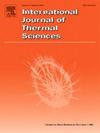Performances of approximate radiative property models for conditions met in ammonia combustion
IF 4.9
2区 工程技术
Q1 ENGINEERING, MECHANICAL
International Journal of Thermal Sciences
Pub Date : 2025-02-24
DOI:10.1016/j.ijthermalsci.2025.109777
引用次数: 0
Abstract
Recent investigations on ammonia as a sustainable fuel highlight the need for proper modelling of the radiative heat transfer in ammonia–air flames. As a result, the present work reports on spectral databases that have been specifically generated, leading to the development of various spectral models, ranging from narrow band models to global ones. These models have been tested against the exact line-by-line (LBL) model for an extended pressure range (1–50 atm) in both premixed and non-premixed flame configurations. Noticeably, the premixed flame structure, which can be represented by a two-layer system, is a challenging configuration for correlated-k distribution models. For this configuration, a detailed investigation of the spectral models on various flame fields led to the conclusion that in spite of a higher computational cost, the Statistical Narrow Band Correlated k-distribution (SNBCK) models are better suited for modelling the radiative processes compared to the full spectrum models, such as the Rank Correlated Full-Spectrum k-distribution (RCFSK), Multi-Scale Rank Correlated Full-Spectrum k-distribution (MSRCFSK), and Weighted Sum of Grey Gases (WSGG). Considering the computational load, a reduced SNBCK model, referred to as SNBCK25, was developed and demonstrated high agreement with the LBL model. As an illustration, for a spherically expanding premixed flame at 20 atm, the SNBCK model had a mean absolute relative error (MARE) of 1.17%, while the SNBCK25, RCFSK with double integration, MSRCFSK, and WSGG models resulted in MARE of 1.87%, 4.62%, 8.23%, and 34.7%, respectively, against the LBL model. It is worth mentioning that the contributions of , , and were not significant to the evaluation of the divergence of radiative heat flux in the LBL model. Hence, these three species were ignored in the subsequent radiative computations.
求助全文
约1分钟内获得全文
求助全文
来源期刊

International Journal of Thermal Sciences
工程技术-工程:机械
CiteScore
8.10
自引率
11.10%
发文量
531
审稿时长
55 days
期刊介绍:
The International Journal of Thermal Sciences is a journal devoted to the publication of fundamental studies on the physics of transfer processes in general, with an emphasis on thermal aspects and also applied research on various processes, energy systems and the environment. Articles are published in English and French, and are subject to peer review.
The fundamental subjects considered within the scope of the journal are:
* Heat and relevant mass transfer at all scales (nano, micro and macro) and in all types of material (heterogeneous, composites, biological,...) and fluid flow
* Forced, natural or mixed convection in reactive or non-reactive media
* Single or multi–phase fluid flow with or without phase change
* Near–and far–field radiative heat transfer
* Combined modes of heat transfer in complex systems (for example, plasmas, biological, geological,...)
* Multiscale modelling
The applied research topics include:
* Heat exchangers, heat pipes, cooling processes
* Transport phenomena taking place in industrial processes (chemical, food and agricultural, metallurgical, space and aeronautical, automobile industries)
* Nano–and micro–technology for energy, space, biosystems and devices
* Heat transport analysis in advanced systems
* Impact of energy–related processes on environment, and emerging energy systems
The study of thermophysical properties of materials and fluids, thermal measurement techniques, inverse methods, and the developments of experimental methods are within the scope of the International Journal of Thermal Sciences which also covers the modelling, and numerical methods applied to thermal transfer.
 求助内容:
求助内容: 应助结果提醒方式:
应助结果提醒方式:


